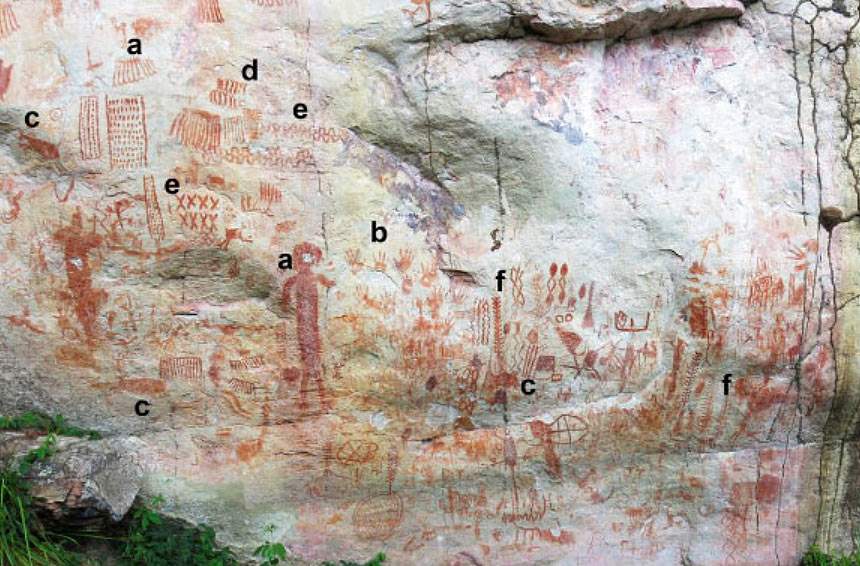Colombia, thousands of cave paintings with giant animal depictions discovered
A year-old discovery of some important cave paintings has been revealed in Colombia: these are numerous images with subjects from the world of flora and fauna as well as numerous symbols, totaling tens of thousands of elements that, say the archaeologists who discovered them, will take a long time to inventory and study. The works were found at the site of Serrania de La Lindosa, near the town of Santa Rosita, in the middle of the Amazon rainforest: the site lies in the middle of a protected area, where indigenous peoples still live. This is not the first time cave paintings have been found in the area: in previous years similar discoveries had been made in nearby Chiribiquete National Park.
The discovery is thanks to a team of archaeologists from the University of Exeter led by José Iriarte and Mark Robinson (University of Exeter), Gaspar Morcote-Ríos (National University of Colombia) and Francisco Javier Aceituno (University of Antioquia), and, as anticipated, was kept secret for a year: the paintings, the experts point out, are found on three rock walls, are large in size (so much so that the press immediately dubbed them “the Sistine Chapel of prehistory”) and date from between 12.600 to 11,800 years ago. The images depict landscapes, geometric shapes, human figures, footprints of the mlans, hunting scenes, animals such as deer, tapirs, alligators, bats, monkeys, turtles, snakes, porcupines, and even the so-called “megafauna” of the Ice Age: these are extinct animals whose only known painted records to date were found in central Brazil. These are large mastodons, strange camelids, hairy horses, ungulates with three-toed legs, and megatherians (i.e., giant sloths that could be up to six meters long).
The team that uncovered the wall finds is composed of Colombian and British archaeologists and is supported by European Research Council Funds. It is research that was made possible by the peace treaty between the FARC, the Revolutionary Armed Forces of Colombia operating in the area, and the country’s government, signed in 2016. It appears, moreover, that neither the indigenous people nor local archaeologists were aware of this site. It is safe to assume, at the very least, that the inhabitants, who recognize as sacred the places of their ancestors, have voluntarily attempted to keep hidden this ancient and evidence that is nevertheless of extreme interest, especially since the painted subjects include animals that are now extinct.
“These are really incredible images,” said Mark Robinson, “made by the oldest people who lived in the western Amazon. They settled here at the time of extreme climate changes, which led to major changes in the vegetation and the appearance of the fortesta. The Amazon was still transforming into the tropical forest we know today. The paintings give us a vivid and exciting glimpse into the lives of these communities. It is incredible for us today to think that they lived among giant herbivores, some of them the size of small cars, and hunted them.”
This is also a rather lucky find because similar paintings were heavily weathered and have not come down to us: however, in this case they are rock walls that are located in an area sufficiently protected from winds and rains, and have therefore been able to come down to us.
“These cave paintings,” José Iriarte points out, “are spectacular evidence of how humans shaped the area, and how they hunted, cultivated and fished. It is as if art was an important part of their culture and a way to connect socially. The images show how people lived among giant, now extinct, hunting animals.”
The study that led to this discovery started in 2017. Now the discovery will be discussed on British broadcaster Channel 4 in the first week of December as part of the program Jungle Mystery: Lost Kingdoms of The Amazon (which has exclusive rights to the images), a program that deals with lost civilizations and prehistory. In the scientific literature, the discovery was instead published in the journal Quaternary International.
Pictured is an image of the newly discovered paintings (a: anthropomorphic shapes; b: handprints; c: zoomorphic figures; d: geometric shapes; e: plants).
 |
| Colombia, thousands of cave paintings with giant animal depictions discovered |
Warning: the translation into English of the original Italian article was created using automatic tools. We undertake to review all articles, but we do not guarantee the total absence of inaccuracies in the translation due to the program. You can find the original by clicking on the ITA button. If you find any mistake,please contact us.




























